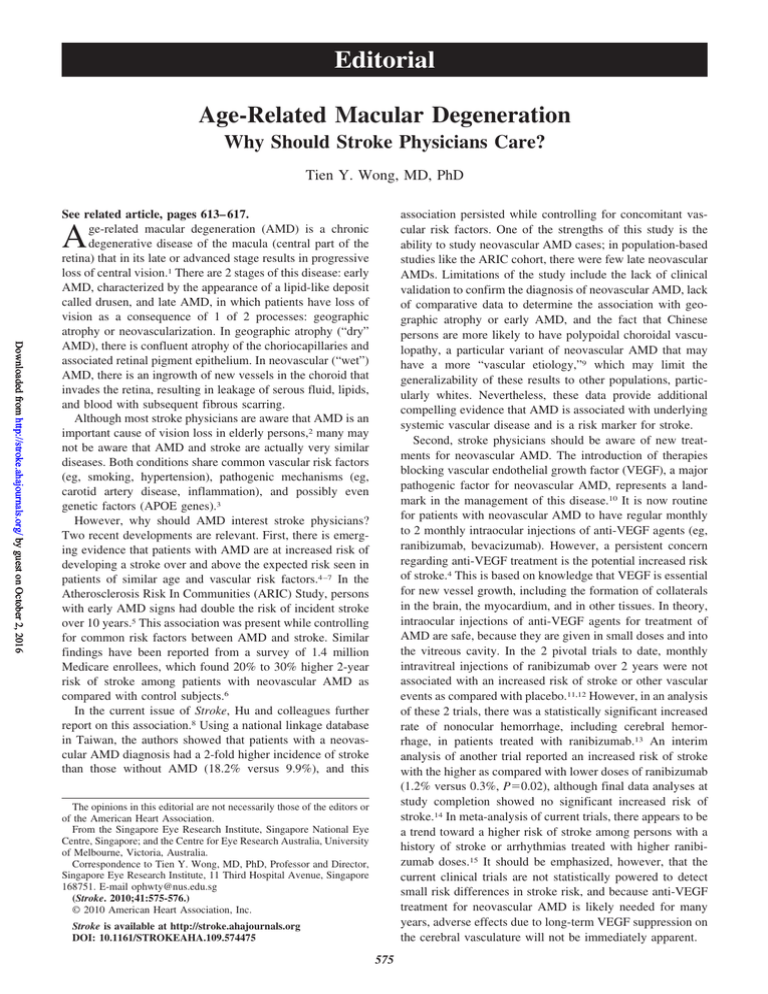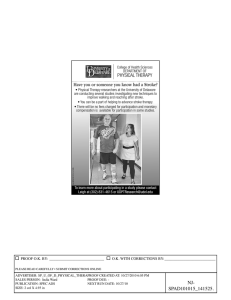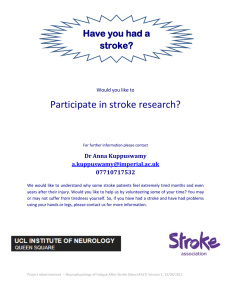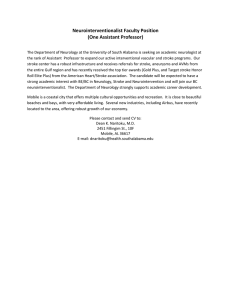
Editorial
Age-Related Macular Degeneration
Why Should Stroke Physicians Care?
Tien Y. Wong, MD, PhD
association persisted while controlling for concomitant vascular risk factors. One of the strengths of this study is the
ability to study neovascular AMD cases; in population-based
studies like the ARIC cohort, there were few late neovascular
AMDs. Limitations of the study include the lack of clinical
validation to confirm the diagnosis of neovascular AMD, lack
of comparative data to determine the association with geographic atrophy or early AMD, and the fact that Chinese
persons are more likely to have polypoidal choroidal vasculopathy, a particular variant of neovascular AMD that may
have a more “vascular etiology,”9 which may limit the
generalizability of these results to other populations, particularly whites. Nevertheless, these data provide additional
compelling evidence that AMD is associated with underlying
systemic vascular disease and is a risk marker for stroke.
Second, stroke physicians should be aware of new treatments for neovascular AMD. The introduction of therapies
blocking vascular endothelial growth factor (VEGF), a major
pathogenic factor for neovascular AMD, represents a landmark in the management of this disease.10 It is now routine
for patients with neovascular AMD to have regular monthly
to 2 monthly intraocular injections of anti-VEGF agents (eg,
ranibizumab, bevacizumab). However, a persistent concern
regarding anti-VEGF treatment is the potential increased risk
of stroke.4 This is based on knowledge that VEGF is essential
for new vessel growth, including the formation of collaterals
in the brain, the myocardium, and in other tissues. In theory,
intraocular injections of anti-VEGF agents for treatment of
AMD are safe, because they are given in small doses and into
the vitreous cavity. In the 2 pivotal trials to date, monthly
intravitreal injections of ranibizumab over 2 years were not
associated with an increased risk of stroke or other vascular
events as compared with placebo.11,12 However, in an analysis
of these 2 trials, there was a statistically significant increased
rate of nonocular hemorrhage, including cerebral hemorrhage, in patients treated with ranibizumab.13 An interim
analysis of another trial reported an increased risk of stroke
with the higher as compared with lower doses of ranibizumab
(1.2% versus 0.3%, P⫽0.02), although final data analyses at
study completion showed no significant increased risk of
stroke.14 In meta-analysis of current trials, there appears to be
a trend toward a higher risk of stroke among persons with a
history of stroke or arrhythmias treated with higher ranibizumab doses.15 It should be emphasized, however, that the
current clinical trials are not statistically powered to detect
small risk differences in stroke risk, and because anti-VEGF
treatment for neovascular AMD is likely needed for many
years, adverse effects due to long-term VEGF suppression on
the cerebral vasculature will not be immediately apparent.
See related article, pages 613– 617.
ge-related macular degeneration (AMD) is a chronic
degenerative disease of the macula (central part of the
retina) that in its late or advanced stage results in progressive
loss of central vision.1 There are 2 stages of this disease: early
AMD, characterized by the appearance of a lipid-like deposit
called drusen, and late AMD, in which patients have loss of
vision as a consequence of 1 of 2 processes: geographic
atrophy or neovascularization. In geographic atrophy (“dry”
AMD), there is confluent atrophy of the choriocapillaries and
associated retinal pigment epithelium. In neovascular (“wet”)
AMD, there is an ingrowth of new vessels in the choroid that
invades the retina, resulting in leakage of serous fluid, lipids,
and blood with subsequent fibrous scarring.
Although most stroke physicians are aware that AMD is an
important cause of vision loss in elderly persons,2 many may
not be aware that AMD and stroke are actually very similar
diseases. Both conditions share common vascular risk factors
(eg, smoking, hypertension), pathogenic mechanisms (eg,
carotid artery disease, inflammation), and possibly even
genetic factors (APOE genes).3
However, why should AMD interest stroke physicians?
Two recent developments are relevant. First, there is emerging evidence that patients with AMD are at increased risk of
developing a stroke over and above the expected risk seen in
patients of similar age and vascular risk factors.4 –7 In the
Atherosclerosis Risk In Communities (ARIC) Study, persons
with early AMD signs had double the risk of incident stroke
over 10 years.5 This association was present while controlling
for common risk factors between AMD and stroke. Similar
findings have been reported from a survey of 1.4 million
Medicare enrollees, which found 20% to 30% higher 2-year
risk of stroke among patients with neovascular AMD as
compared with control subjects.6
In the current issue of Stroke, Hu and colleagues further
report on this association.8 Using a national linkage database
in Taiwan, the authors showed that patients with a neovascular AMD diagnosis had a 2-fold higher incidence of stroke
than those without AMD (18.2% versus 9.9%), and this
A
Downloaded from http://stroke.ahajournals.org/ by guest on October 2, 2016
The opinions in this editorial are not necessarily those of the editors or
of the American Heart Association.
From the Singapore Eye Research Institute, Singapore National Eye
Centre, Singapore; and the Centre for Eye Research Australia, University
of Melbourne, Victoria, Australia.
Correspondence to Tien Y. Wong, MD, PhD, Professor and Director,
Singapore Eye Research Institute, 11 Third Hospital Avenue, Singapore
168751. E-mail ophwty@nus.edu.sg
(Stroke. 2010;41:575-576.)
© 2010 American Heart Association, Inc.
Stroke is available at http://stroke.ahajournals.org
DOI: 10.1161/STROKEAHA.109.574475
575
576
Stroke
April 2010
Thus, physicians should be alerted to the possibility of an
increased risk of stroke in elderly patients with AMD and that
this risk may be further accentuated by the use of anti-VEGF
therapy.
Disclosures
T.Y.W. has been a Consultant to Novartis, Pfizer and Allergan, and
has received research grants, honoraria, and consultancy fees from
these companies.
References
Downloaded from http://stroke.ahajournals.org/ by guest on October 2, 2016
1. Wong TY, Chakravarthy U, Klein R, Mitchell P, Zlateva G, Buggage R,
Fahrbach K, Probst C, Sledge I. The natural history and prognosis of
neovascular age-related macular degeneration: a systematic review of the
literature and meta-analysis. Ophthalmology. 2008;115:116 –126.
2. Klein R, Peto T, Bird A, VanNewkirk MR. The epidemiology of agerelated macular degeneration. Am J Ophthalmol. 2004;137:486 – 495.
3. Baker ML, Hand PJ, Wang JJ, Wong TY. Retinal signs and stroke:
revisiting the link between the eye and brain. Stroke. 2008;39:1371–1379.
4. Wong TY. Age-related macular degeneration and cardiovascular disease
in the era of anti-vascular endothelial growth factor therapies. Am J
Ophthalmol. 2009;148:327–329.
5. Wong TY, Klein R, Sun C, Mitchell P, Couper DJ, Lai H, Hubbard D,
Sharrett AR; Atherosclerosis Risk in Communities Study. Age-related
macular degeneration and risk for stroke. Ann Intern Med. 2006;145:
98 –106.
6. Liao D, Mo J, Duan Y, Klein R, Scott IU, Huang KA, Zhou H. Is
age-related macular degeneration associated with stroke among elderly
Americans? Open Ophthalmol J. 2008;2:37– 42.
7. Tan JS, Wang JJ, Liew G, Rochtchina E, Mitchell P. Age-related macular
degeneration and mortality from cardiovascular disease or stroke. Br J
Ophthalmol. 2008;92:509 –512.
8. Hu CC, Ho JD, Lin HC. Neovascular age-related macular degeneration
and the risk of stroke: a five year population-based follow-up study.
Stroke. 2010;41:613– 617.
9. Laude A, Cackett PD, Vithana EN, et al. Polypoidal choroidal vasculopathy and neovascular age-related macular degeneration: same or different disease? Prog Retin Eye Res. 2009 Oct 23 [Epub ahead of print].
10. Wong TY, Liew G, Mitchell P. Clinical update: new treatments for
age-related macular degeneration. Lancet. 2007;370:204 –206.
11. Rosenfeld PJ, Brown DM, Heier JS, Boyer DS, Kaiser PK, Chung CY,
Kim RY; MARINA Study Group. Ranibizumab for neovascular agerelated macular degeneration. N Engl J Med. 2006;355:1419 –1431.
12. Brown DM, Kaiser PK, Michels M, Soubrane G, Heier JS, Kim RY, Sy
JP, Schneider S; ANCHOR Study Group. Ranibizumab versus verteporfin for neovascular age-related macular degeneration. N Engl J Med.
2006;355:1432–1444.
13. Gillies MC, Wong TY. Ranibizumab for neovascular age-related macular
degeneration. N Engl J Med. 2007;356:748 –749.
14. Boyer DS, Heier JS, Brown DM, Francom SF, Ianchulev T, Rubio RG. A
Phase IIIb study to evaluate the safety of ranibizumab in subjects with
neovascular age-related macular degeneration. Ophthalmology. 2009;
116:1731–1739.
15. Schmidt-Erfurth U. Clinical safety of ranibizumab in age-related macular
degeneration. Expert Opin Drug Saf. 2010;9:149 –165.
KEY WORDS: age-related macular degeneration
vascular endothelial growth factor
䡲
epidemiology
䡲
stroke
䡲
Age-Related Macular Degeneration: Why Should Stroke Physicians Care?
Tien Y. Wong
Downloaded from http://stroke.ahajournals.org/ by guest on October 2, 2016
Stroke. 2010;41:575-576; originally published online February 11, 2010;
doi: 10.1161/STROKEAHA.109.574475
Stroke is published by the American Heart Association, 7272 Greenville Avenue, Dallas, TX 75231
Copyright © 2010 American Heart Association, Inc. All rights reserved.
Print ISSN: 0039-2499. Online ISSN: 1524-4628
The online version of this article, along with updated information and services, is located on the
World Wide Web at:
http://stroke.ahajournals.org/content/41/4/575
An erratum has been published regarding this article. Please see the attached page for:
/content/41/7/e512.full.pdf
Permissions: Requests for permissions to reproduce figures, tables, or portions of articles originally published
in Stroke can be obtained via RightsLink, a service of the Copyright Clearance Center, not the Editorial Office.
Once the online version of the published article for which permission is being requested is located, click
Request Permissions in the middle column of the Web page under Services. Further information about this
process is available in the Permissions and Rights Question and Answer document.
Reprints: Information about reprints can be found online at:
http://www.lww.com/reprints
Subscriptions: Information about subscribing to Stroke is online at:
http://stroke.ahajournals.org//subscriptions/
Correction
In the editorial “Age-Related Macular Degeneration: Why Should Stroke Physicians Care?” by
Wong,1 the companion article to this editorial, reference 8, was incorrectly cited in the reference
list. Although the authors and title were correct, the volume, issue, and page range were incorrect.
The reference should be cited as:
8. Hu CC, Ho JD, Lin HC. Neovascular age-related macular degeneration and the risk of
stroke: a five year population-based follow-up study. Stroke. 2010;41:613– 617.
The publisher regrets this error.
The corrected version can be viewed online at http://stroke.ahajournals.org/cgi/content/
full/41/4/575.
1
[Correction for Vol 41, Number 4, April 2010. Pages 575–576.]
(Stroke. 2010;41:e512.)
© 2010 American Heart Association, Inc.
Stroke is available at http://stroke.ahajournals.org
DOI: 10.1161/STR.0b013e3181e9c53f
e512




